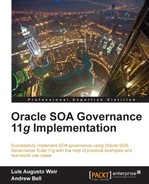This chapter will introduce the Oracle Service Registry (OSR), a fully v3-compliant implementation of the UDDI (Universal Description, Discovery, and Integration) specifications, and a key component of a Service Oriented Architecture (SOA). A UDDI Registry provides a standards-based directory for locating and invoking services and for managing service metadata such as security, transport, quality of service, and service endpoints.
We will discuss the purpose of the Registry and highlight the differences between OSR and the Oracle Enterprise Repository (OER). We will also discuss the product architecture and how the Registry can be employed to assist in the overall SOA Governance effort. It should be noted that it is not our intention to write a full tutorial for OSR and the reader should seek alternative sources of information for a more in-depth, step-by-step tutorial of the product.
We will also examine some of the theory that lies behind the UDDI specifications and how services can be classified in the Registry to assist consumer searches. Again, we will introduce some of the concepts behind UDDI, but a more detailed description can be found online at http://uddi.org/pubs/uddi-v3.00-published-20020719.htm#_Ref8978020.
The OSR provides a standards-based mechanism to classify, catalog, and manage services, so that they can be discovered and consumed by other applications, and is a key component of an SOA. The registry stores details of each service including metadata such as security, transport protocols, and quality of service:

OSR is fully compliant with the UDDI v3 specification that describes details for the implementation of a service registry and associated programmatic interfaces. UDDI supports the description and discovery of:
- Businesses, organizations, and other Service Providers
- The services they publish
- The technical interfaces that may be used to access and manage these services.
OSR promotes service re-use by allowing consumers to easily locate published services using categorization rules (taxonomies) that are either industry-standard or specific to an individual organization. The registry provides information on security and transport protocols supported by a given service and the parameters required to invoke the service. OSR also supports versioning of services and endpoint virtualization. The latter allows services to be moved or migrated from one server or another, which can prove extremely useful particularly in the development environments where services are promoted between development, test, and production servers. URLs are resolved by the registry at runtime rather than developers embedding them into applications.
The OSR serves as an integration point for runtime tools such as Oracle Service Bus and Oracle SOA Suite 11 g . For example the Oracle Service Bus can automatically publish and subscribe to new or modified assets.
In addition, OSR supports the design time discovery of Assets using tools such as JDeveloper, which further supports and maximizes the discovery and re-use of existing published services, many of which can be created by external organizations.
